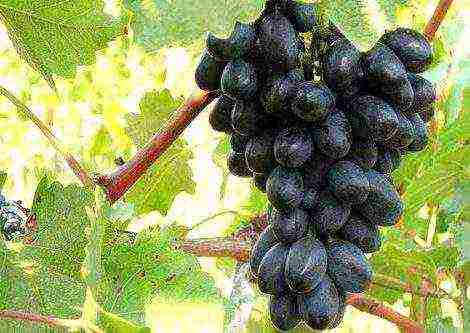Content [show]
Garlic is an essential hot spice in cooking. It has a pungent taste and rich aroma and health benefits. Growing garlic is a simple process, therefore, it is on every site. You can find a description of the most popular varieties and varieties in this review.
Varietal variety of garlic
However, not everyone knows that there are more than 70 varieties of garlic! This means that you can choose according to your taste, focusing on the conditions of a particular site with its soil, climate characteristics, location. Moreover growing experience suggests that you should not limit your choice to one or two varieties. It is worth trying a few, and only after leaving the ones you like.
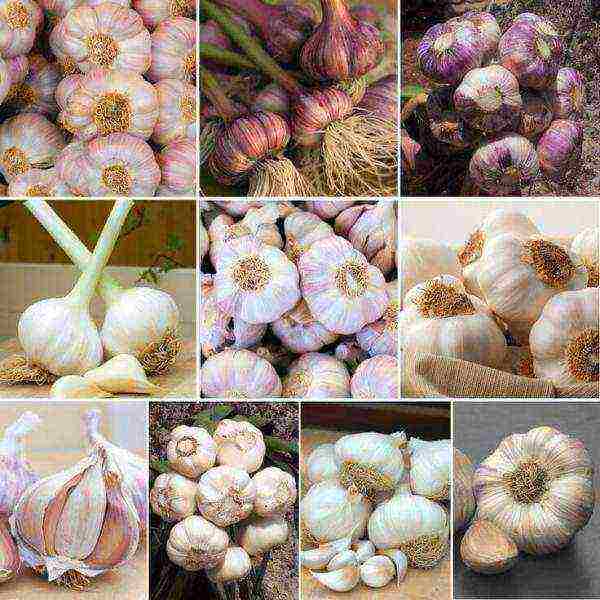 More than 70 varieties of spring and winter garlic are known
More than 70 varieties of spring and winter garlic are known
Such a variety makes sense, since some ripen earlier and they can be added to dishes already at the beginning - in the middle of summer, used for canning. Others ripen later, but are better stored.
Most popular varieties
Since the varietal variety is great, this article describes popular, popular varieties.
Spring
Spring garlic differs from winter garlic in different planting periods (spring garlic is planted in spring, and winter garlic - in late autumn), yield - spring garlic is less productive, unlike winter garlic.
To visually recognize spring garlic, you need to pay attention to the following signs:
- spring garlic without central bararound which the denticles are located;
- themselves spiral teeth - the closer to the center, the smaller they are;
- teeth can differ from each other by size and shape;
- spring garlicno arrows.
Popular varieties of spring garlic:
Victorio
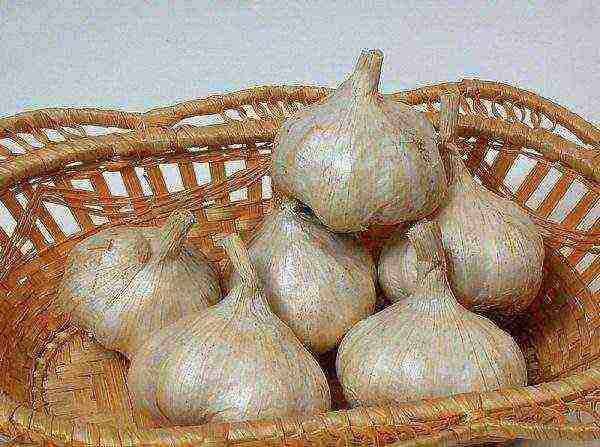 Spring Garlic Victorio
Spring Garlic Victorio
Mid-season, high-yielding species. No arrows, resistant to pests and fungal diseases... The bulbs are flat-round in shape, the color of the scales is yellow-white.
Yelenovsky
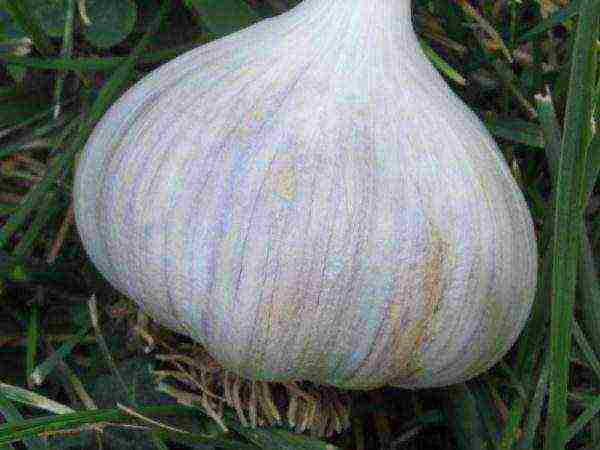 Spring garlic grade Yelenovsky
Spring garlic grade Yelenovsky
Mid-season, fruitful, round heads. Outside, the color of the scales is whitish, and inside, on the teeth themselves, it is pinkish... Demonstrates resistance to all plant diseases.
Gulliver
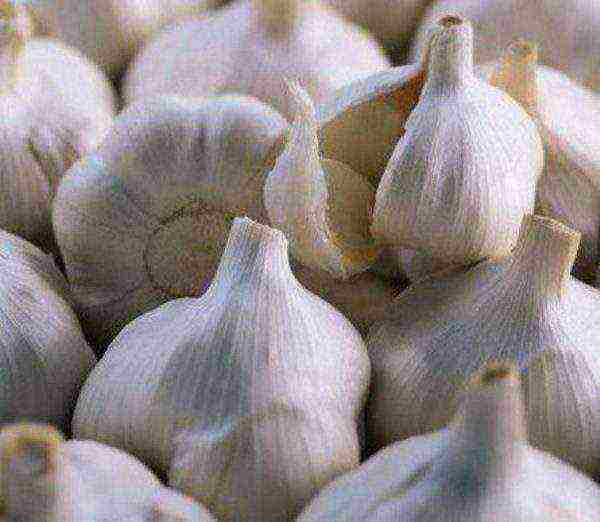 Spring garlic variety Gulliver
Spring garlic variety Gulliver
Considered mid-late. The harvest is good, it produces arrows. The bulb is round, slightly flat. The color of the scales is light, white. Little susceptible to diseases and pests.
Sochi 56
 Spring garlic grade Sochi 56
Spring garlic grade Sochi 56
Mid-season, gives a stable and high-quality harvest. The shape of the head is slightly flat, rounded. The color of the scales can be white or purple, and on the teeth themselves - pink with a purple tint.Resistant to disease.
Ershovsky
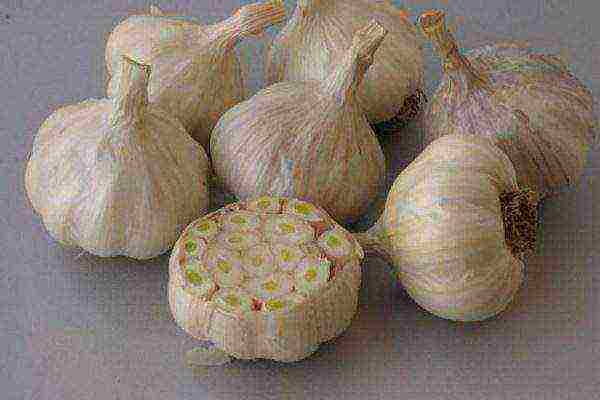 Spring garlic grade Ershovsky
Spring garlic grade Ershovsky
Belongs to mid-season, the bulbs are round, slightly flat. It does not produce arrows, the harvest is excellent. Resistant to disease.
Winter crops
For winter garlic, the following signs are characteristic, by which it can be visually recognized:
- rod in the center of the headaround which the denticles are located;
- the teeth are arranged in a circle, in one row;
- teeth the same;
- harvest gives higher;
- in winter crops -arrows grow on which tiny onions are then formed.
The best-selling varieties of winter garlic are:
Lyubasha
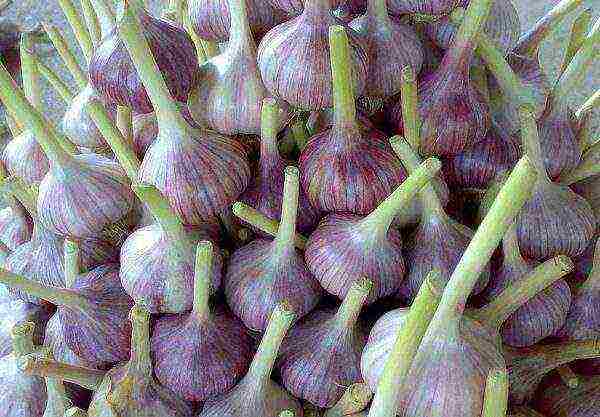 Winter garlic grade Lyubasha
Winter garlic grade Lyubasha
Withstands severe frosts and dry summers. It is considered quite high - the stem is up to 120 cm. The bulb is round, slightly flat. The color of the scales is light with streaks of violet tones, resistant to diseases. Keeps perfectly. It has a bright spicy taste and is suitable for canning.
Dobrynya
 Winter garlic variety Dobrynya
Winter garlic variety Dobrynya
A productive variety, but less frost-resistant than Lyubasha. The heads are large, not too sharp, so it is good to eat it fresh. Ripening period - late. Dobrynya is well stored and is not susceptible to disease.
Sofievsky
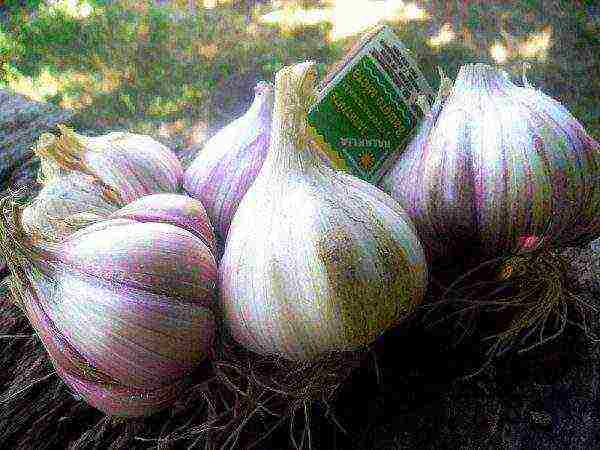 Winter garlic Sofievsky grade
Winter garlic Sofievsky grade
It perfectly tolerates severe frosts, but in summer it is picky about heat and light. Not too high - about 70 cm. Large onion - 100 g with large cloves. The color of the scales is pale purple. Nematode resistant, moderately pungent taste.
Alcor
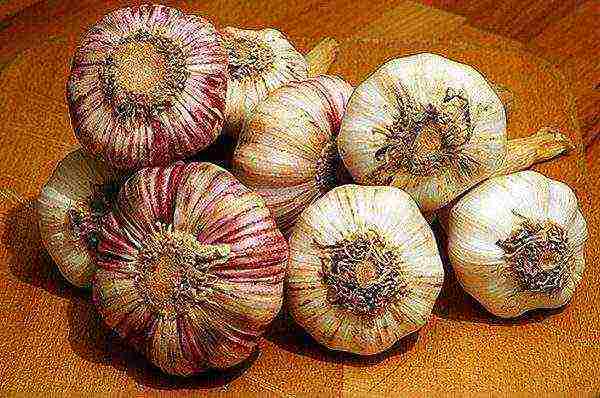 Winter garlic grade Alkor
Winter garlic grade Alkor
High-yielding, excellent storage. The color of the bulb is pinkish, and the cloves themselves are closer to gray. Damaged by yellow dwarfism.
Dubkovsky
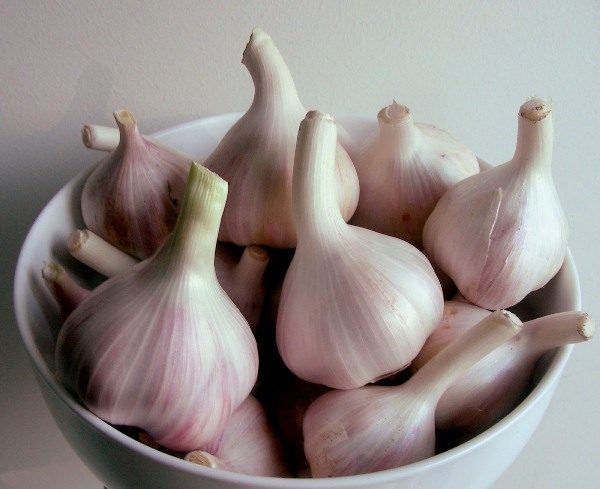 Winter garlic variety Dubkovsky
Winter garlic variety Dubkovsky
High yielding, good storage performance. The stem is of medium height, the bulb is not large, rarely weighs more than 50 grams. It is stored excellently, the taste is spicy.
In winter crops, it is imperative to cut off the arrows at the base, otherwise the head will be shallow. Do not break the arrows so as not to damage the bulb.
Shooters
Garlic that produces arrows is sharper in taste, more productive than varieties without arrows, it is better stored. Among the shooters, the most noticeable are:
Gribovsky jubilee
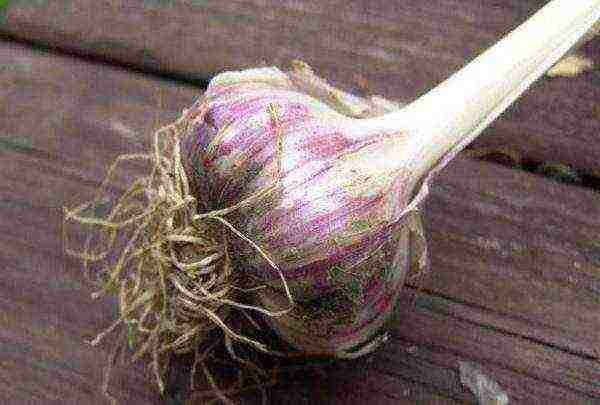 Shooting garlic variety Gribovsky jubilee
Shooting garlic variety Gribovsky jubilee
Medium-sized winter variety. The color of the scales is reddish-purple. Disease resistance - at a high level, stored well.
Gribovsky 60
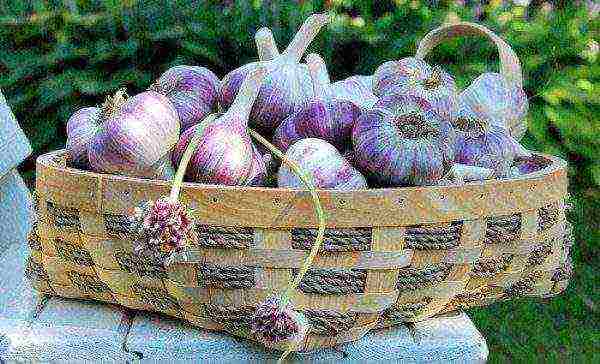 Shooting garlic grade Gribovsky 60
Shooting garlic grade Gribovsky 60
Harvest early ripening, resistant to freezing and drought. The bulb is medium in size and keeps well. Not damaged by bacteria and viruses.
Scythian
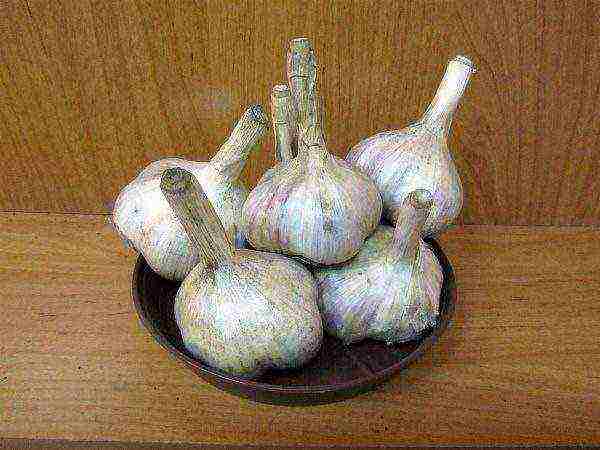 Shooting garlic grade Skif
Shooting garlic grade Skif
Frost-resistant variety, resistant to diseases of this plant. The color of the scales is gray with streaks of purple, and the teeth themselves are creamy.
Large-toothed Kiseleva
 Shooting garlic grade Skif
Shooting garlic grade Skif
Early ripening, the head is more than average, about 80 g, the taste is pleasant, spicy. It is not susceptible to disease, shelf life is long.
Hermann
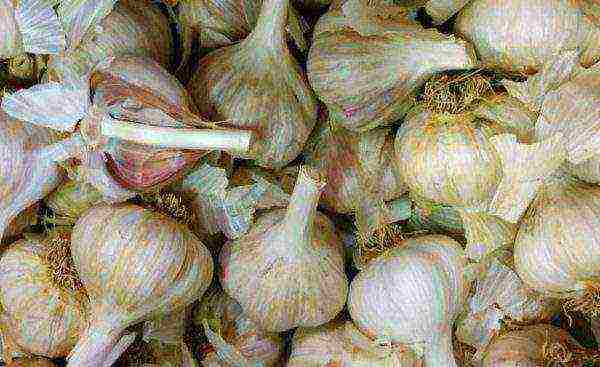 Garlic variety Herman
Garlic variety Herman
The bulb is round, conical, the color of the scales is whitish-lilac, and the cloves are cream. Stored up to 8 months, resistant to fungal and bacterial infections.
Non-arrow
Of the non-shooting, the following are popular:
Aleisky
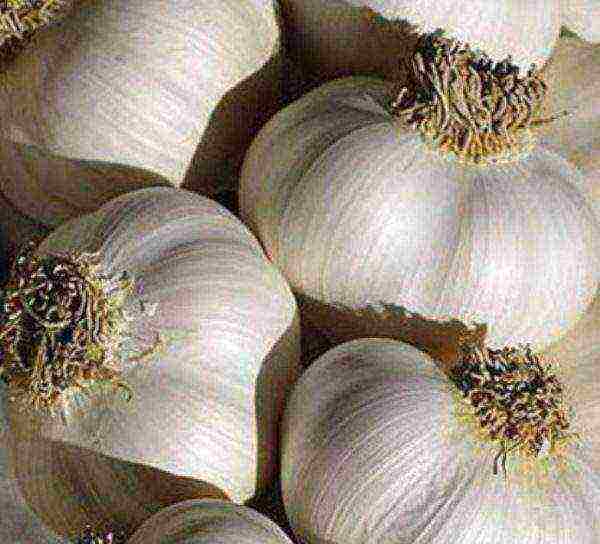 Aleisky garlic variety
Aleisky garlic variety
Mid-season, round bulb, flat, stored until spring.
Moskovsky
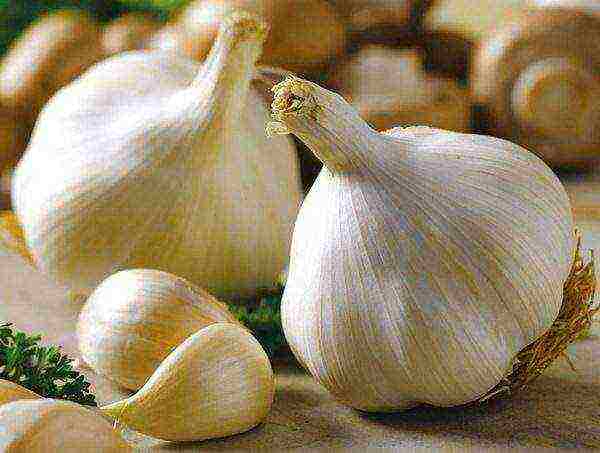 Garlic variety Moscow
Garlic variety Moscow
Mid-season, well kept, not too sharp the color of the scales is light, the teeth are white.
Abrek
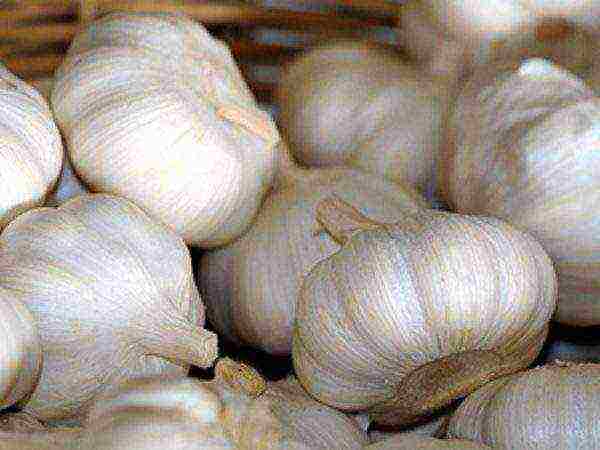 Garlic variety Abrek
Garlic variety Abrek
Similar to Moscow, but the head is slightly larger.
Odessa 13
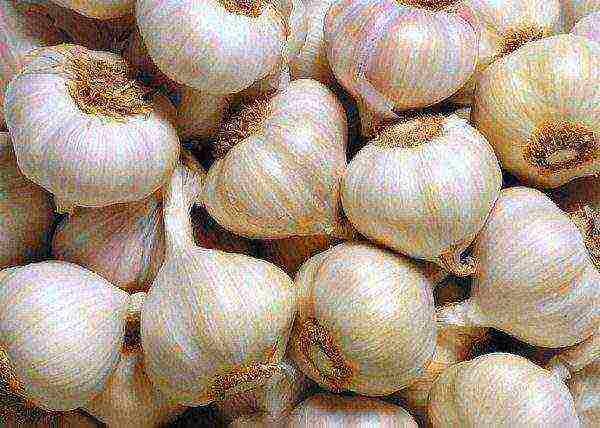 Garlic variety Odessa 13
Garlic variety Odessa 13
It happens spring and winter, the color of the scales is white, sometimes with stripes of purple tones, stored wonderfully.
Gafurian
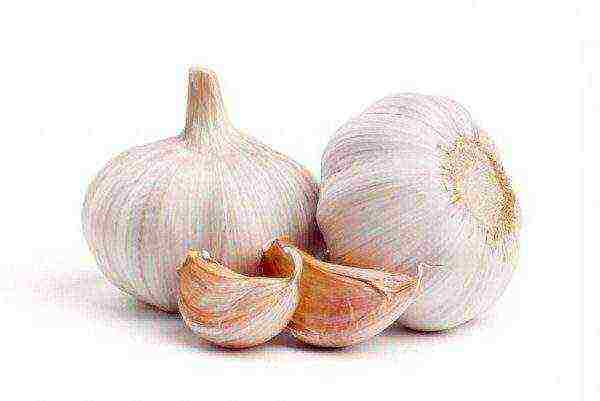 Garlic variety Gafurian
Garlic variety Gafurian
Medium-sized onion up to 40 grams, round, flat. Resistant to rot, but sometimes it is prone to powdery mildew.
The best large varieties
Of the varieties with a large head, the following are known:
Alekseevsky (giant)
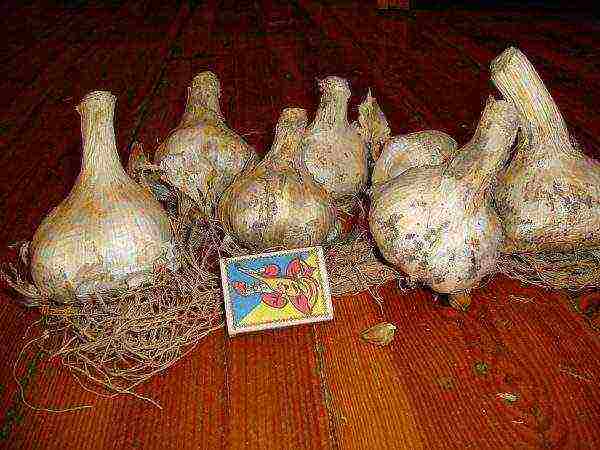 Garlic Alekseevsky (giant)
Garlic Alekseevsky (giant)
The bulb reaches 250 gr. Wherein resistant to disease and stored for a long time.
Komsomolets
 Garlic Komsomolets
Garlic Komsomolets
Shooting, winter, mid-season, flat-round onion, the taste is pungent.
Petrovsky
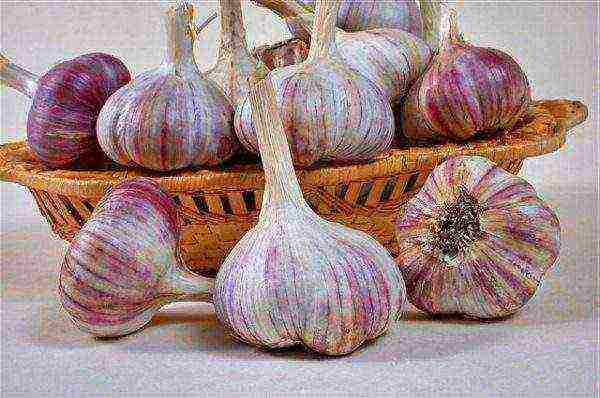 Petrovsky garlic
Petrovsky garlic
Looks like Komsomolets, resistant to disease.
Degtyarsky
 Degtyarsky garlic
Degtyarsky garlic
Spring, without arrows, the taste is moderately spicy.
Orlovsky
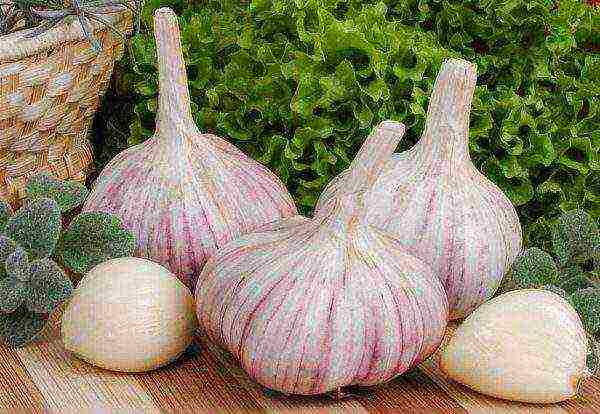 Garlic Orlovsky
Garlic Orlovsky
Spring, does not release arrows, onion over 100 gr.
Conclusion
These are not all varieties of garlic that are worthy of attention. AND do not be afraid to try new selection - there are many good varieties among them!
Garlic has long been very popular, as it is widely used in cooking, and is also appreciated as a very effective remedy against various diseases. Now there are a variety of varieties of garlic that summer residents plant on their backyard plots.
What are the types of garlic
Garlic varieties are simply striking in their variety, but it is worth noting that it can be of winter and spring types. Winter crops are planted in autumn, and spring crops - in early spring. When ripe, winter fruits give an arrow with an inflorescence, where small bulbs then ripen. Winter garlic varieties are much more fertile and also have larger teeth. However, they persist much worse, and if the winter is harsh, severe frosts and very little snow, then they simply freeze out.
Each type of garlic has its own pros and cons. The varieties of this plant differ according to certain characteristics, namely:
- winter garlic has a core in the middle;
- teeth are arranged in one row around the rod;
- spring does not release arrows.
Spring garlic does not have a rod, its teeth are arranged in a spiral manner in 2-3 rows, and the closer they are to the center, the smaller they are. The winter garlic teeth are arranged in a straight line. These varieties have fewer teeth, but they are even and large.
Spring Garlic Varieties
To get a good harvest, you first need to choose the right variety for planting. It is necessary to plant spring varieties of garlic in early spring. The most popular varieties of this type are:
- Victorio;
- Gulliver;
- Yelenovsky;
- Flavor;
- Ershovsky.
The medium-ripe spring variety Victorio is characterized by a very good yield. The shape of its bulbs is flat-round, with white-yellow scales, each weighing about 40 grams. The variety is resistant to various diseases and pests. It keeps well and has a semi-sharp taste.
Garlic of the Gulliver variety belongs to the medium-late species, characterized by a high degree of fruiting. This is the only spring species producing arrows. Its fruits are quite dense, rounded, but at the same time slightly flattened. It is characterized by a high degree of resistance to diseases and pests. It has a pungent aftertaste, and one onion can weigh 90-120 grams. Keeps well throughout the winter.
The Yelenovsky garlic variety is considered one of the best for growing on an industrial scale, as it is characterized by a very good yield and keeping quality. The number of cloves is 3-7, the weight of each reaches 5-8 grams.
Spring Garlic Flavor is well known all over the world. This is an old, time-tested variety with good marketability. This variety gives a very good harvest, large bulbs that can be stored without problems until the next harvest.
It matures very well even in the harshest conditions. According to the reviews of the owners of summer cottages, garlic planted in spring gives guaranteed good results, since in a short time it manages to fully ripen and form dense and powerful heads.
Winter garlic varieties
Many are interested in what varieties of garlic are the best for planting in the fall. Many people prefer to plant winter garlic for its large fruits and good taste.Most of its fruits are produced by arrows, but there are varieties without arrows.
Planting winter garlic is preferable in late September or early October. The best varieties of winter garlic are listed below:
- Alcor;
- Lyubasha;
- Hermann;
- Dobrynya;
- Zubrenok;
- Antonik.
Variety Alkor - mid-season, arrow, the height of the arrow reaches 60-100 cm. It is recommended to plant the plant in a large area and private household plots. The root bulb has 4-5 large cloves. It has a rather pronounced pungent taste. The main advantage of this variety is the high yield and good quality of the fruit.
Lyubasha's garlic is especially popular. The description of the variety suggests that it is universal. It is characterized by resistance to drought and cold. The plant is light-loving enough, capable of growing up to 100-150 centimeters in height. It must be planted exclusively in open areas, without shading. The shape of the heads is somewhat flattened, they reach a weight of 120 grams.
The Lyubasha garlic variety is famous for its very good taste and high nutritional value. Fruits are covered with dry scales of pink or whitish color. There are 5-9 large teeth on the head, each reaching 15-20 grams.
The semi-sharp variety Dobrynya is distinguished by good keeping quality, high yield, medium frost resistance, large head size, resistance to various diseases and pests. Dobrynya is a late-ripening variety that produces arrows, one of the few cultivated throughout Russia. Its application is universal. They are often used in the preservation of vegetables and mushrooms. Also used as a seasoning and as an independent pickling product.
The largest-fruited varieties of garlic
Recently, vegetables have begun to appear, striking in their large size. Garlic is also no exception. There are quite popular large varieties of garlic, in particular such as:
- Gulliver;
- Titanium;
- Moskal;
- Alekseevsky.
Titan garlic is considered a very good mid-late garlic. The period of its growing season is quite long and is 100-115 days. Bushes are low, powerful. The heads reach 150-180 grams in size, and often contain 6 cloves. The rounded flat bulb is covered with lilac-purple scales, the flesh is white and juicy, with a sharp taste. Garlic keeps well after harvest.
Moskal garlic also belongs to large varieties. It is high-yielding, slightly tangy in taste. The Alekseevsky variety is characterized by a very good yield and resistance to diseases and pests. Differs in good preservation due to the high strength of the scales. The heads have 4-5 teeth and reach a weight of 150-180 grams. The taste of the pulp is sweet-spicy, and the aroma is quite delicate, pronounced garlic.
The best shooting varieties
To find the best look, you need to study the description of the varieties of garlic, this will allow you to get a good harvest. The best shooting varieties include:
- Sofievsky;
- Komsomolets;
- Saved;
- Moscow region;
- Bashkir-85.
Sofievsky belongs to mid-season varieties, resistant to diseases, characterized by very good yield and quality. The bulbs are large, rounded flat in shape, weighing 80-120 grams and are distinguished by a light purple shade of scales and a pungent taste.
Komsomolets belongs to mid-season varieties with large, dense heads. The main advantages of this variety are high yield, good commercial qualities, versatility of application. In addition, it is resistant to various diseases and bacteria.
Bashkir-85 is one of the most popular early-maturing varieties. Its bulbs weigh about 60 grams and can be eaten fresh, and is also good for canning and cooking.
How to choose non-shooting varieties
Non-shooting garlic varieties can be both winter and spring varieties, as they develop equally well in any conditions. It reproduces only by teeth, regardless of the disembarkation period. The main advantage of this type is that there is no need to break out arrows. The most popular varieties include:
- Novosibirsk;
- Broadleaf-220;
- Healer.
Broadleaf-220 belongs to early maturing varieties of universal use. Its heads weighing about 40 grams each have 8-10 teeth and are characterized by a delicate semi-sharp taste. Among the main advantages of this variety, it is necessary to highlight high yield, resistance to various kinds of diseases.
The doctor is considered one of the most popular early maturing varieties with many cloves. This variety is distinguished by good yield, excellent frost resistance, keeping quality, transportability.
Novosibirskiy belongs to mid-season varieties, characterized by increased frost resistance. Fruits are medium-sized, pinkish in color, containing 4-10 cloves of spicy taste. They are suitable for cooking and fresh consumption.
What is the difference between spring garlic and winter garlic
Varieties of spring and winter garlic differ not only in the planting period, but also in yield and shelf life. Spring varieties are less productive, but their heads can be preserved until the next harvest with almost no loss. Winter varieties are intended primarily for fresh consumption.
It is imperative to properly prepare the planting material in order to guarantee a good result.
Garlic planting feature
Garlic prefers well-lit places, which is why it should be planted away from shrubs and trees. In shaded areas, the heads grow very small, and their taste is unsaturated. In the area where garlic is planted, there should be no stagnant water.
The soil should be loamy. In autumn, it is advisable to add compost or manure and complex mineral fertilizers.
Before planting garlic, you must first inspect the cloves, they must be completely healthy. You can take large ones left over from the previous harvest or specially grown from seeds. Initially, you need to soak them for 30 minutes in a weak solution of potassium permanganate to protect against possible diseases.
Garlic care
If there is little snow in winter, then you need to take additional care of the garlic so that it does not freeze. For this, the beds are insulated. In the spring, after the formation of the first shoots, with an insufficient amount of moisture, garlic must be watered. After that, you need to periodically water the garlic, but make sure that there is no stagnation of moisture. Watering stops about a month after harvesting.
It is recommended to feed when the bulb grows. It is imperative to carry out loosening and remove weeds. In varieties that form arrows, they need to be broken off in June, then all the nutrients will go to the bulb.
Harvesting garlic
When the top leaves of the garlic turn half yellow and the bottom ones dry out, you can harvest the garlic. Garlic harvested early is very poorly preserved. Spring garlic is harvested when the leaves are completely yellow and fall on the ground, mainly in September.
The garlic is dug up and then pulled out of the ground, holding by the tops. After harvesting, it must be dried in the garden bed, spread out in rows. After the garlic dries, it should be transferred to a warm, well ventilated area. After a week, cut off the tops and roots, and then dry for another 2-3 weeks.
Reviews of different varieties of garlic
According to reviews, many people prefer to plant Lyubasha, Gulliver, Bogatyr garlic. These varieties are characterized by good yield, disease resistance, keeping quality. It is best to purchase varietal garlic for planting in specialized stores.
Do you know how to distinguish spring garlic from winter garlic and which varieties of spring garlic are considered the best? If not, be sure to read this article.
Today we will tell you what are the features of spring garlic and which varieties are ideal for your site.
What is the difference between spring garlic and winter garlic
Varieties of spring and winter garlic differ not only in terms of planting (spring is planted in spring, and winter - in autumn). Very important indicators for them are yield, as well as shelf life. Spring varieties are usually less productive, but their bulbs are able to survive until the next harvest with little or no loss. While winter varieties of garlic are mainly intended for fresh consumption and canning. And spring garlic (unlike winter garlic) perfectly tolerates spring cold snaps. But such varieties will not be able to survive the winter frosts.
Visually distinguish between winter and spring garlic by the following features:
- winter garlic has a central shaft around which chives are attached. If you separate all the cloves of garlic, then only such a "stick" will remain in the center. Spring garlic does not have such a central core.
- cloves of spring garlic are arranged in a spiral in 2-3 rows (the closer to the center, the smaller the cloves), and cloves of winter varieties are placed neatly around the rod in 1 row.
- winter garlic has fewer cloves and is smoother in shape and size. But spring garlic has more cloves, and they can differ significantly from each other.
- spring garlic cloves are smaller in size, and in winter varieties they are larger, and the yield is higher.
- spring varieties of garlic are non-shooting (except for the "Gulliver" variety), but winter varieties are shooting. They "throw out" arrows with air bulbs, which serve for reproduction.
To prepare the planting material, separate and exfoliate the garlic cloves. After 4-5 days, sort them by size. Remove all dry, rotten and diseased specimens immediately, and select healthy large and medium-sized cloves for planting. Store the garlic at a temperature of 16-20 ° C, and transfer it to a cool place with a temperature of 2-5 ° C 25-30 days before planting.
The best varieties of spring garlic
To get a good harvest, it is important to choose the right variety of spring garlic. We will tell you about the 5 most popular and well-proven varieties.
Victorio
Mid-season, non-shooting, high-yielding variety. The bulbs are flat-round, with yellow-white dry scales. Disease resistant.
| Use | Taste | Number of teeth | Bulb weight (g) | Keeping quality | |
| peninsular |
13-15 |
excellent | |||
Gulliver
Medium late shooted high-yielding variety. Bulbs are dense, flat-rounded, off-white scales. Disease resistant.
| Use | Taste | Number of teeth | Bulb weight (g) | Keeping quality | |
| spicy |
4-5 |
90-120 |
excellent | ||
Yelenovsky
Mid-season non-shooting variety. Differs in stable productivity and high quality products. The bulbs are firm, round and flat-round. The outer scales are white, the inner ones are creamy pink. Resistant to major diseases of garlic.
| Use | Taste | Number of teeth | Bulb weight (g) | Keeping quality | |
| peninsular |
15-18 |
17-23 |
good | ||
Ershovsky
Mid-season, non-shooting, high-yielding variety. The bulbs are flat-round, with white dry scales. Disease resistant.
| Use | Taste | Number of teeth | Bulb weight (g) | Keeping quality | |
| peninsular |
16-25 |
good | |||
Sochinsky 56
Mid-season, non-shooting, high-yielding variety. The bulbs are rounded and flat-round, with white or violet common dry scales, and pink-brown or pink-purple cloves. Resistant to major diseases of garlic.
| Use | Taste | Number of teeth | Bulb weight (g) | Keeping quality | |
| peninsular |
15-30 |
about 50 |
excellent | ||
These varieties of spring garlic will allow every summer resident to get an excellent harvest. Choose the one you like the most and welcome spring fully armed.
Growing any culture, I want to select the best species that will delight not only in the process of growth, but also in the end when cooking. Not surprisingly, many people want to know the best varieties of garlic in order to get a hot seasoning for a variety of dishes. You will learn about the most prolific, hardy and enjoyable varieties of winter and spring garlic in this article.
Criterias of choice
Different varieties of garlic obviously suit different planting conditions. When choosing a garlic suitable for your site, it is important to take into account the weather in the region, the soil composition, which plants have already been planted or are planned for planting. Some hybrids of the variety do not require special preparation of the site; it is enough just to disinfect the soil and apply fertilizers to it.
However, for most varieties, the place is extremely important (it should be light, without stagnant water), a certain type of soil (loamy with neutral acidity), predecessors (best of all, cabbage, melons, legumes, peas). By following the basic rules of crop rotation, you can harvest a larger crop, but also ignoring them, you can ruin the seed and not get anything usable at the end of the season.
If you plan to use garlic only for cooking, winter varieties are best. If you want to breed it for sale or industrial processing, you should pay attention to spring species.
The way of storage, which will be convenient for you, is also of great importance. Often it is enough to arrange spring garlic in bunches, and then hang it in a cool dry place, where it will hang until spring. But with winter crops it will not work out so easily, since the storage duration is noticeably shorter. It can be dried and ground into a powder, or cut into cubes and sent to the freezer. However, such storage rarely exceeds 3-4 months.
The best spring varieties
Spring garlic is planted in the spring, from early April, and harvested from mid-August or early September. The garlic head consists of 15-20 teeth, which are arranged in a spiral - from the smallest in the center to the largest on the outer axis. This species is distinguished by a long shelf life and good yield, but at the same time it cannot boast of a pungent taste.
Degtyarsky
Mid-season garlic with light green leaves and a rounded bulb. The leaves grow up to 37 centimeters, have a weak waxy coating, and are suitable for use in salads. The garlic head can contain up to 18 cloves, although it does not differ in its large weight, rarely exceeding 35-38 grams. The husk is red-white, the flesh is dense, semi-sharp.
Flavor
A mid-season crop that does not release an arrow. The garlic head reaches 55 millimeters in diameter, the average weight is 80 grams. The scales are light pink, the flesh is white, dense, of medium sharpness. The number of cloves is 15-20 pieces. It is characterized by excellent keeping quality, resistant to fungal diseases.
Moskovsky
A mid-season type of garlic that does not release an arrow. Bulb weighing up to 15-20 grams, round. Quite a productive variety: about 2.5 kilograms of garlic can be harvested from 10 square meters. The denticles are dense, almost not sharp in taste. The waxy bloom on the leaves is medium, they can be eaten during the growing season.
Ershovsky
Mid-season plant that does not release an arrow. The leaves are rich green with a medium waxy bloom, reaching 50 centimeters in length. The garlic head is round, weighing up to 35 grams. The number of cloves ranges from 16 to 25, they are dense, the taste is medium sharp. Retains all qualities when stored for up to 7 months.
Abrek
Mid-season variety, no arrow. The leaves are rich green, medium wax bloom, grow in length up to 58 centimeters. Bulbs weighing up to 30 grams with 15 cloves. The flesh of the teeth is dense, white, pungent in taste. Retains all qualities during storage for up to 7 months.
Aleisky
Mid-season variety, does not release an arrow.The leaves are green with a medium waxy bloom, about 33 centimeters long. Garlic heads are small, rarely exceed 17 grams, contain 15-18 cloves, pungent in taste. Despite the good keeping quality, this variety is very susceptible to bacterial rot and fusarium.
The best winter varieties
Winter varieties of garlic are planted for the winter, usually from September until mid-October. Having a high frost resistance, the cloves easily overwinter under the "cap" of snow, and then quickly grow at the first hint of warmth. The harvest time for winter garlic is mid-July. The bulb, in contrast to the spring varieties, is simple with 7-9 cloves located close to the stem. For the winter, the beds are mulched with grass, leaves, sawdust or needles.
Lyubasha
Tall, mid-season garlic. The leaves reach 50 centimeters long, they are moderately covered with a waxy coating, so that they are suitable for consumption as they grow. Garlic heads are large, weighing up to 120-130 grams, and consist of 4-7 cloves. The husk is white with a pattern of purple veins.
Gribovsky Jubilee
A mid-season, versatile arrowhead species. The weight of the bulb rarely exceeds 44 grams, it is round itself, contains up to 11 cloves. Coating in the form of 4-6 dry creamy scales with veins of dark purple color. Medium spicy taste.
Gribovsky 60
Early maturing, shooting variety. Differs in increased resistance to fungal diseases. The garlic head grows up to 60 grams in weight and is rounded. Contains 5 to 12 cloves, very spicy in taste.
Alcor
Mid-season, arrowed species. Designed for long-term storage, retains all useful qualities, has a high yield. The bulbs grow up to 40 grams in weight and contain 4-6 cloves. The husk is deep purple with pink undertones. The leaves grow up to 100 centimeters long and are suitable for consumption.
Saved
Mid-season, high-yielding garlic, suitable for long-term storage. Garlic heads grow up to 100 grams in weight and contain 7-10 cloves. The husk is grayish-red with deep purple veins. The height of the bush can reach 70 centimeters. "Spas" is resistant to fusarium and nematode.
Sofievsky
Mid-season, high-yielding variety, suitable for long-term storage. Garlic heads are round, light purple in color, weighing up to 120 grams, contain up to 8 cloves. Leaves grow up to 70 centimeters long. "Sofievsky" is extremely resistant to nematode.
Yelenovsky
Arrow-releasing plant with mid-season bulbs. Its peculiarity is high frost resistance and productivity. Garlic heads are white, weighing up to 50 grams, contain 4-7 cloves. The leaves are 70 centimeters long. It is extremely resistant to bacterial diseases.
Video "How to choose a variety of garlic"
This video will tell you how the varieties of your favorite culture differ and which one is better to plant on your land.
